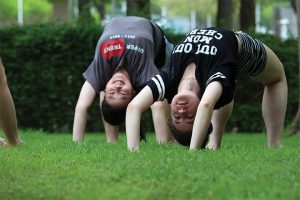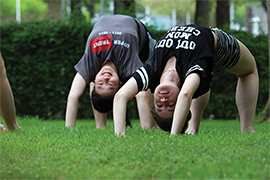Research supports the importance of mindfulness: a new way to find time in the day for yourself
On a typical busy day, junior Frances Burton moves from morning classes to student council meetings during conference, which often run into lunch, to her afternoon classes, to track practice after school and almost immediately to homework when she returns home. But along the way, she doesn’t forget to smile.
From the start of the school day at 8:30 a.m. to the time they return home at 6:30 p.m. or even later, Hockaday students endure a hectic schedule. According to Burton, the process of completing the day’s work and moving on to tomorrow’s work overrides the importance of taking breaks.
Yes, Burton is stressed. But she manages her cramped schedule with a technique written by Gretchen Rubin called “The Happiness Project,” which features a study about the influence of actions on emotions.

“If you act happy and smile, even if you’re not feeling that way, it will start to send messages to your brain that you feel happy,” Burton said. “Sometimes in the morning when I’m really tired and really don’t want to take on the day, I’ll just smile and force myself to be positive for five minutes and it just picks my attitude up for the day.”
The study relates to the growing practice of Mindfulness, a movement which promotes living in and accepting the present, by working on slowing down the brain and controlling emotions.
A New Type of Exercise
Recently, the process of mindfulness has been attributed to increased relaxation responses of the brain. According to Women’s Health Magazine, worrying about the past activates the sympathetic nervous system (the fight-or-flight response), but the practice of mindfulness works the parasympathetic nervous system, which triggers relaxation responses.
Upper School health teacher Rebekah Calhoun has heard about the growing incorporation of mindfulness in education; for example, Hockaday has tried to incorporate mindfulness into its Whole Girl Program.
“The huge thing is that it can hopefully relieve some of the negative impacts and negative health consequences of sustained stress and sustained engagement of the stress responses,” Calhoun said, describing the program.
Guidance counselor Dr. Margaret Morse became familiar with the ideas of mindfulness by reading other psychology publications like “Buddha’s Brain” by Rick Hanson and “Whole Brain Child” by Daniel J. Siegel and Tina Bryson, which introduce the connection to depression and anxiety.
“Depression is being upset about the past and anxiety is being worried about the future, and mindfulness is all about being present in the moment. It’s not that you don’t have those thoughts, it’s about not letting them consume you,” Morse said.
Calhoun recognizes the health benefits of mindfulness, which can decrease stress. “I think [mindfulness] is helpful, but I don’t think it would work for everyone. I think anything that helps us to manage that stress response and regulate it and get back to that homeostasis [could work],” she said.
Finding Time for Yourself
The first step of mindfulness is to find a comfortable place and focus on breathing. One of the suggested activities in the article from Women’s Health Magazine is yoga, due to the concentration on breathing.
“Breathing, as in focusing on deep breaths, is a very good place to start. It’s something that you can do immediately in any situation,” Morse said. “It’s not just breathing; it’s deep breathing and focusing on the air going into your lungs and then holding it and exhaling.”
The positive benefit of mindfulness is the mobility and the ease of the practice; for example, the core of mindfulness, breathing, doesn’t require a large amount of time.
“You just start small; breathing is something that you can do immediately and in any situation,” Morse said. “You can always just breathe.”
After regulating breathing, focusing on the minute details helps stop nervous feelings by slowing down the thought process. “You focus on the presence of what it’s like to have air in your lungs or for you to really stop and see what you really look like,” Morse said. “It’s about trying to slow down in the moment. If you physically slow down, then your brain slows down and stops racing.”
Creating a Mindful Community
Incorporating mindfulness into the community or a daily routine begins with an awareness of the practice. Calhoun tries to incorporate a moment of self-reflection at the start of her health classes.
“I do this with my class every once and a while. I say ‘I don’t want you to do anything. I just want you to sit there and be for 10 minutes,’” Calhoun said. “It’s not about thinking about anything; it’s not about doing anything; it’s just take a deep breath and just be.”
But with the busy schedules of the average Hockaday students, there is a limited amount of time in the day, and that makes it difficult to create time to reflect and rest. Calhoun is not sure, however, that adding mindfulness to the health curriculum would be effective.
“Having it in health class is easy. My concern with having it in health class is that it becomes something that we only do in health class, and we don’t take it out of the room,” Calhoun said. “I’ve done it some as a still, quiet movement when I talk about stress with my freshmen. I feel like if I take that time to do that every class, people would love it, but I don’t think they would take it out of the class and do it somewhere else.”
On the other hand, English Department Chair Dr. Deborah Moreland incorporates meditation into her class time.
Burton, one of Moreland’s students, appreciates the action of meditation in class, but she also agrees with Calhoun.
“We meditate for five minutes at the start of class, and I really enjoy that. It actually helps. But I could never see myself doing that outside of class,” Burton said.
The main issue with incorporating mindfulness into the daily routine is the cultural idea that we always need to be working on or accomplishing a task, and the uneasiness associated with doing nothing.
“I think people don’t know how to do that very well because we are so wired and so busy. I think we have lost that art of being alone and being still, being quiet and being by ourselves,” Calhoun said. “We, as a culture, not just a Hockaday thing, but an American thing, are okay to do health things if they are convenient, but if they’re not, we just don’t have time for it.”
– Claire Fletcher



